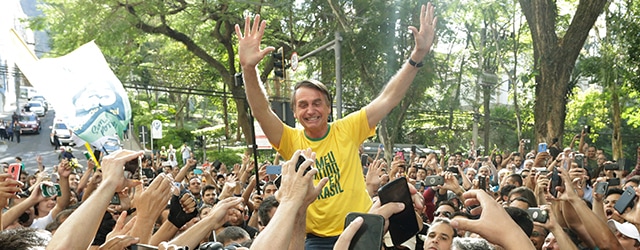Whoever emerges on top of Brazil’s political system after this year’s election will face questions that have no good answers.

Any way you look at it, Brazil’s 2018 presidential election was bizarre. The most popular candidate—former President Luiz Inácio Lula da Silva—is facing corruption charges. He campaigned from a prison cell, only to see his candidacy nixed by judicial decision. The sitting president, Michel Temer, wasn’t in the running; yet he, too, faces corruption allegations. As Global Finance went to press, prosecutors were seeking to bring charges against two more candidates. Most remarkably, the leading right-wing candidate, sometimes called the “Brazilian Trump,” was stabbed in the stomach at a rally in September. Despite the perils, more than a dozen candidates waged a fierce contest for the main Planalto Palace chair.
Whoever ends up winning, a new presidential term will start January 1 with unrealistic expectations for the new head of state to solve the interrelated problems of increasing public debt, low economic growth and a political environmentunfavorable to reform. “This will be a very disputed election, and most of the losers will make the president’s life a hell,” says Sergio Vale, chief economist of MB Associados.
Brazilian public debt hit a new high in June—77.2% of GDP—even with a little help from state development bank BNDES. This debt is an albatross around the neck of the emergent economy, and an issue that the next president cannot avoid. President Temer fought hard for some hugely unpopular reforms to Brazil’s generous pension system to mitigate that debt, including raising the age to collect benefits, but was unable to pass the legislation.
“Without Social Security reform to be implemented at the beginning of the new administration, we will face 2019 in fiscal crisis,” Vale says. “The current fiscal agenda will be demolished automatically, and the debt will reach more than 80% of the GDP.”
It’s a conundrum for the next administration. Without reforms, Brazil may not attract enough foreign investors to grow. With reforms, the newly elected president will certainly sacrifice popularity, but the country’s GDP should grow, albeit slowly—perhaps enough to shore up her/his campaign for re-election in 2022. The Institute of International Finance warns that the election of radically different leadership will increase risk either way: The loss of confidence would throw the country again into recession and add at least 5 percentage points to its debt ratio.
The political tea leaves are hard to read. In addition to a new president, October’s election will change many senators, members of congress and state governors. Their positions on fiscal adjustment and other related issues are still unpredictable. “After years of recession, low economic growth, high unemployment and corruption scandals, the new president will find a more angry and demanding society,” says Vale. “We hope the political class does not prevent the new administration from reforming Social Security.”
For 2019, considering the continuity of the current fiscal agenda, economic analysts and international organizations are estimating a GDP growth between 2.0% and 2.7%. However, these projections have been revised from more-ambitious numbers due to political uncertainty, the corruption scandals and the consequences of May’s truck drivers’ strike, which paralyzed the country.
Early expectations of an economic recovery in 2018 have evaporated, and projections now are for growth between 1% and 1.5%. Although inflation remains under control (4.16% estimated to the end of the year), and the Selic interest rate is at a record low (6.5% per year), 13 million Brazilians have no job and another 47.1 million toil in the informal labor market. This means that the country still faces low consumer spending, constrained also by the banks’ high interest rates.
Many people ejected from the formal labor market are now informal entrepreneurs. According to LCA Consulting, there are 897,000 people leading small, informal companies—51% higher than in 2016—that provide jobs to 1.9 million workers.
The contagiousness of the Turkish and Argentine crises makes financial market gurus, such as Mohamed El-Erian, predict that Brazil could be the next to fall. In fact, in early September, Brazil’s currency had lost 21% of its value since January, with a US dollar worth 4.2 Brazilian reais. Hefty international reserves—around US$380 billion—are forestalling major damage.
For most Brazilian workers, entrepreneurs and economic sectors, 2018 is another year lost. But despite all the uncertainty and headwinds, the real Brazilian economy is still moving. Some sectors—such as farming, processed foods and energy/oil—have relatively rosy prospects. Still, there is a long list of sectors with critical infrastructure needs for transportation, water supply and sewage. Economist Raul Velloso estimates that Brazil needs to invest between 4% and 5% of its GDP in infrastructure every year during the next two decades in order to achieve the same growth as other Latin American countries. During the past two decades, it invested only 2% of GDP per year.
“It is essential to introduce a productivity agenda for the medium and long terms, with a focus on private investments in infrastructure,” recommends Otaviano Canuto, a member of the executive board of the World Bank. “Brazil will have to deal with this challenge. But, just like the rest of the world, the country cannot guarantee security and predictability.”



